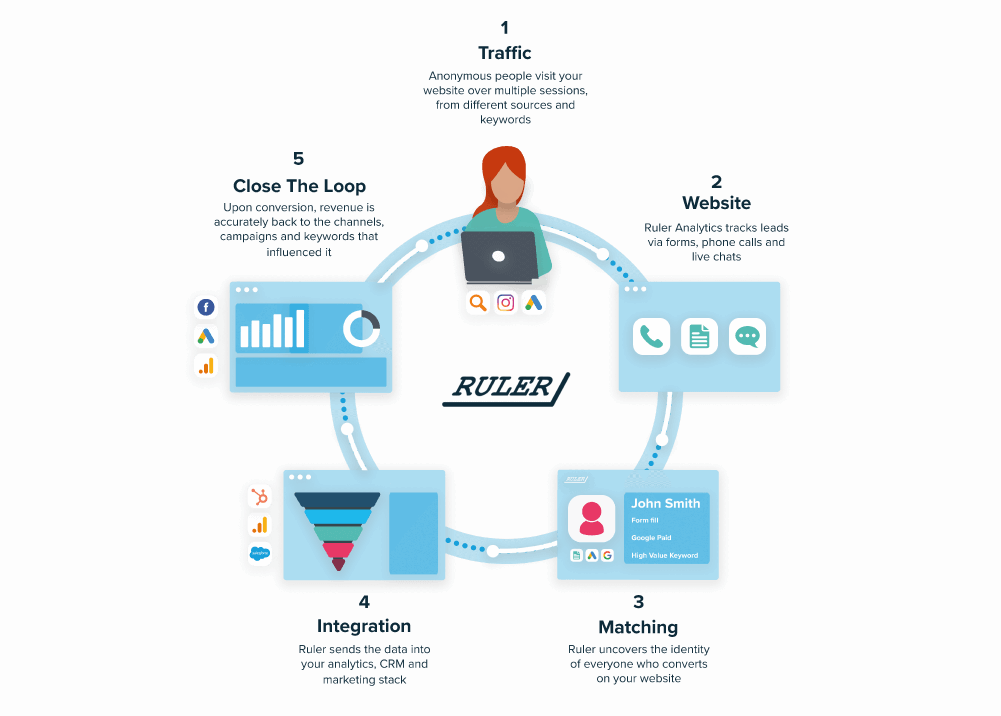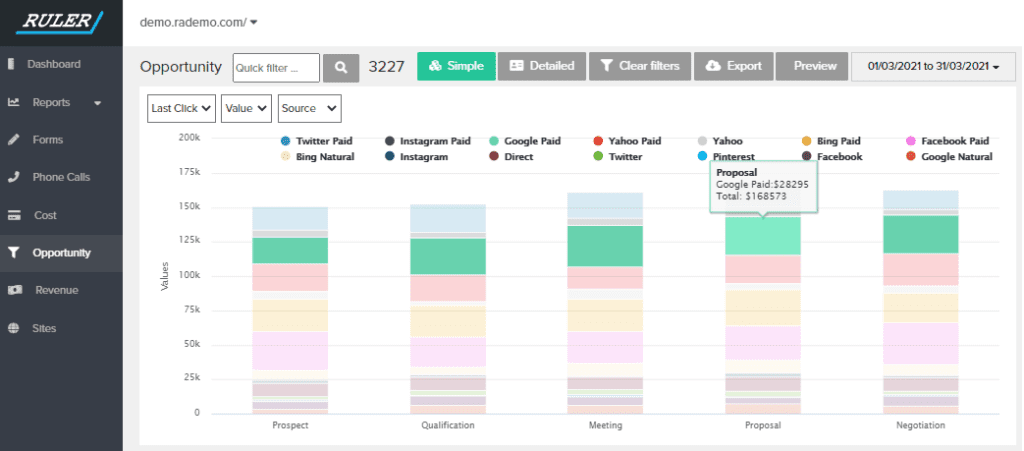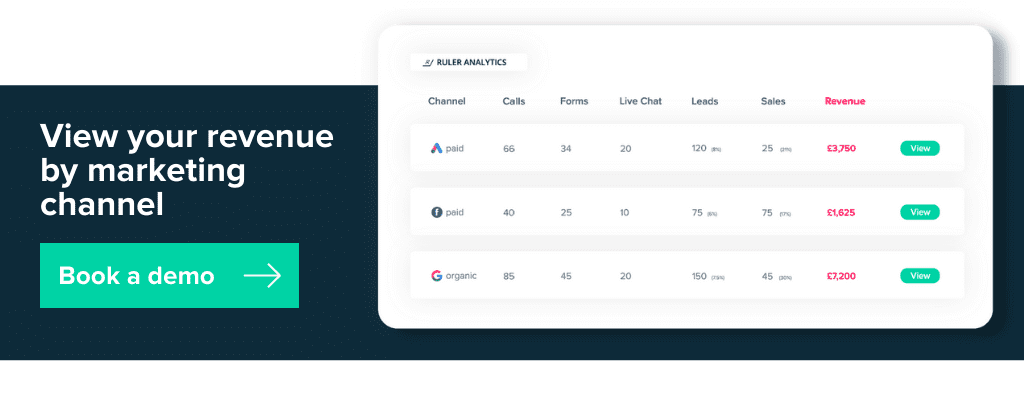Tracking lead source in your CRM allows you to better measure, plan and optimise your marketing efforts to generate more solid results for your business.
Many marketers are under pressure to prove their impact on revenue.
As a matter of fact, when asked, 55% of marketers quoted increasing ROI as their ‘primary marketing goal’.
To effectively prove impact on revenue, marketers are becoming more focused on lead source tracking in the CRM to assess which lead generation tactics are driving the most profitable results.
While lead source tracking may seem obvious for measuring the true impact on your marketing, knowing where to start can be a daunting task.
Having helped many companies close the loop between leads to revenue, we thought we’d outline the steps for lead source tracking.
Plus, explain how you can use lead source data to measure the effectiveness of your lead generation campaigns.
For this article, we’ll discuss:
💡 Pro Tip
Looking for an easy way to close the loop between your marketing and revenue data. Ruler provides a single source of truth on what lead generation campaigns are working well to drive revenue for your business.
How Ruler attributes revenue to your marketing
Lead source in your CRM software records how leads and customers found your business.
Keeping track of the source of your leads is a great way to assess the effectiveness of your marketing campaigns.
Related: What is lead source tracking and how to get started
Generally, your CRM will come with default values that allow you to track channels such as website, phone inquiry and referral. Though very handy to have, the default options available in most CRM’s aren’t very specific.
So, a lead converted on your website? What marketing source did they use to find your website in the first place?
Using the default values in the CRM, you’d never know.
Fortunately, most reputable CRMs allow you to edit and add your own specific lead sources.
By identifying the specific sources that drive the most opportunities, you can guide your teams towards the channels that deliver the best quality leads and sales at the lowest possible cost.
Without visibility across all lead sources, you lack insight into which marketing touchpoints make up the most valuable leads and customers.
By measuring specific lead sources in the CRM, you can track what channels to spend on and drive more qualified leads at a lower cost.
For example, let’s say your manager hands over more budget and tasks you with the goal of increasing annual revenue by 15%.
At first, you log into Google Analytics and see that Facebook has generated the most leads. You look over at Google Paid and notice that the conversion rate is lower.
Based on those learnings, you’d likely focus your budget towards Facebook and scale back or retire your Google Ads campaigns.
But, while Facebook is generating the most leads, how can you know for certain it’s making an impact on your bottom line?
You can’t.
But, with lead source tracking in the CRM, you can reveal which lead generation techniques are having the best impact on your ROI and make better decisions to reach your goals—faster.
With lead source tracking set up, you might find that while Facebook has a higher conversion rate, the majority of your leads are poor quality and are actually wasting your time and money.
Google Ads, on the other hand, has a much higher ROI and lifetime value.
Tracking lead source data in your CRM is crucial, but many marketers are having a difficult time doing it. Let’s discuss why.
Most reputable CRMs come with built-in labels that allow you to assign lead source values.
While these lead sources provide some indication of the effectiveness of your advertising campaigns, they’ll often merge all your digital channel activity into one category, such as “Web”.
This makes it difficult for marketing and sales to pinpoint the specific digital channels that are driving qualified leads into the CRM.
And, this is where things start to get fuzzy.
Marketing loses sight of their online leads in the CRM as they’re lumped into one data set and are left guessing as to what drives opportunities, revenue and repeat purchases.
Your leads will use several traffic sources to track down information, services and products. In fact, 73% of all customers will use multiple channels during their purchase journey.
As a result, many marketers are finding the process of capturing lead source across multiple touchpoints more and more of a challenge.
Unfortunately, things are only going to get worse, as leads continue to adopt more channels to learn about products and services.
And as the customer journey continues to get more complicated, so will the process of capturing lead source data.
💡 Pro Tip
We wrote a handy guide to tracking your customer touchpoints, so you can stay on top of your journeys and be in the know.
Download the guide on tracking customer journeys
Most CRM systems can only apply one primary source value to each lead. This is very limiting, especially if you have a multi-channel approach to marketing.
For example, let’s say you own a car dealership and decide to run an interest-free finance deal in your local area.
To attract awareness, you run a paid campaign on Facebook.
At the dealership, a sales rep is approached by a potential buyer who saw your Facebook offer.
They hand over their details and eventually convert into a sale.
It’s fair to say that both the Facebook Ad and the offline event played a part in the exchange.
However, most CRMs would only attribute this lead to one source.
The question is, what lead source would you attribute the sale to?
The sales wouldn’t have happened if it wasn’t for the sales rep.
But, the buyer would never have visited the car dealership if it wasn’t for the Facebook ad.
To track specific lead source data, you’ll need a solution that can capture all touchpoints across multiple channels and integrate with your CRM to attribute leads and sales accordingly.
Using a tool like Ruler, you can seamlessly track the source of your leads and sales in your CRM, without having to do any manual work.
Put simply, Ruler is a marketing attribution solution for digital marketers who want to measure, track and analyse lead and customer behaviour across the full customer journey.
Related: How Ruler tracks full customer journeys
It completely aligns lead and sales activity by attributing closed revenue correctly across your marketing channels, campaigns, keywords, ads and more.
Ruler helps marketers connect their marketing and sales activity by automatically enriching lead data with information previously locked in marketing tools, such as:
Here’s a closer look at how it works.

Anonymous users engage with your marketing campaigns and ultimately land on your website. Ruler tracks each and every visitor individually, allowing you to isolate activity down to the specific lead source.
When a visitor provides information about themselves, whether they fill out a form, make a telephone call, or request a demo, Ruler will update the data on that user to create a journey map for what is now known as a lead.
All the information Ruler has captured on your lead, such as their marketing source and customer journey, is sent to your CRM. Such connectivity helps your sales team track where leads are coming from and better assess the quality.
Naturally, your leads will progress through the sales cycle, going from simple contact to a fully qualified sales opportunity.
For some businesses, however, the sales process can stretch over a number of weeks and usually involves more touchpoints along the path to purchase.
Fortunately, Ruler lets you analyse the effectiveness of your lead sources at every stage of the buyer’s journey.
Here is a screenshot of Ruler, providing us with key information at different stages of the sales pipeline.

As you can see, Google Ads was responsible for driving £28,295 to the proposal stage, whereas Google Organic only added £7,695.
You could apply this insight to your marketing and invest more budget into Google Ads as you know for certain that it has a greater impact on the opportunity pipeline.
When sales convert leads and enter the value into the CRM, that data is fed back to Ruler.
Related: How Ruler attributes revenue to your marketing
Such connectivity gives you a complete view of exactly which lead sources are contributing the most revenue.
It doesn’t stop there.
When an opportunity is marked as closed or won in your CRM, Ruler can automatically send the value of the lead or sale to your favourite sales and marketing tools.
Editor’s Note: Ruler integrates with 1000+ tools. See a list of the most popular integrations here.
For example, Ruler integrates with Google Analytics and allows you to import data on new form fills, live chat sessions, calls and sales.
When a lead converts into revenue, Ruler will automatically pass this data to your Google Analytics reporting suite, allowing you to measure marketing performance alongside all your traditional metrics.

In this example, you can see how much revenue each channel is working to generate through set goals created with Ruler.
Both Facebook and Instagram have generated the same amount of leads.
But, when we look at the value, we can see that Facebook has contributed 5x more revenue.
Just one benefit of many available with Ruler.
💡 Pro Tip
Learn more on how to send lead source and revenue data to Google Analytics and understand which marketing sources generate the most revenue, both online and offline.
Unlock marketing revenue in Google Analytics
Effectively tracking lead source data in your CRM allows your sales team to have more targeted and personalised conversations with prospects.
Marketing, on the other hand, benefits from key insights that allow them to adjust their advertising strategies to significantly increase marketing ROI.
It’s a win-win situation for everyone involved.
Want to know more about tracking lead source data in your CRM? Book a demo today and learn more about the possibilities of Ruler.
